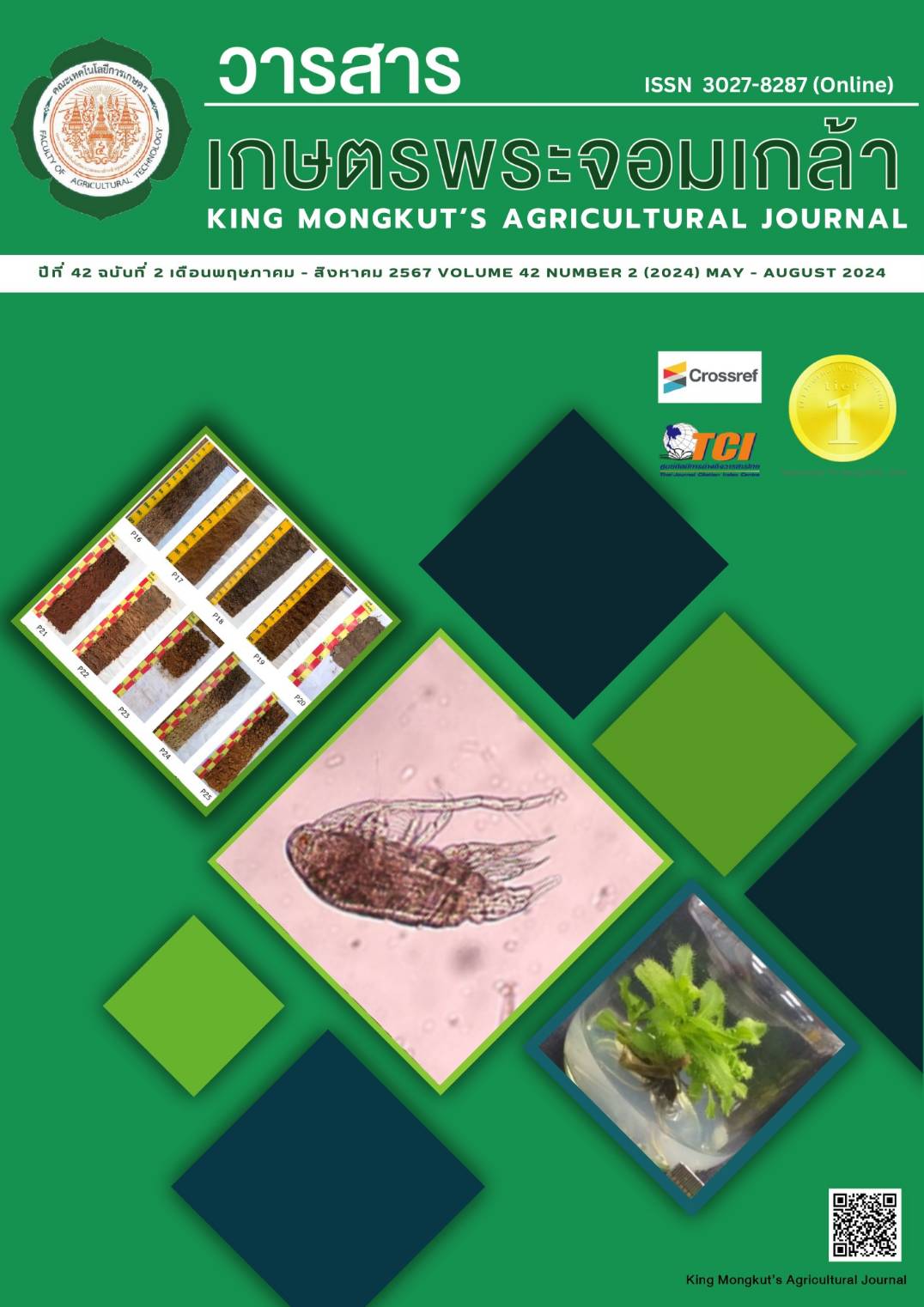Physiological Responses of Different Aged Rice Seeds to Osmopriming with PEG 6000
Main Article Content
Abstract
The objective of this research was to compare the quality of different aged rice seed after priming. The rice seeds were deteriorated by accelerated aging method at 44 °C and relative humidity 100%, in different periods for 0 (without accelerated aging), 1, 2, 3, and 4 days. Then, the germination of rice seeds of different ages were induced by soaking in 30% of PEG 6000 solution at room temperature for 24 hours. After that, the rice seeds were dried in a hot air oven at 35 °C for 10 hours until the moisture content was close to the initial moisture. Finally, these treated rice seeds were examined for the seed quality of various characteristics such as seed germination rate (planted in the laboratory and field conditions), germination index, speed of germination, and electrical conductivity of solution used for soaking seeds. The results showed that the electrical conductivity of all different aged seeds decreased after priming. For the field of germination and germination uniformity, it was found that the seeds with different rates of deterioration showed different responses to the priming. Aged seeds with germination rates of 12 and 33 percent germination were able to induce germination rate by 27 and 48 percent, respectively, while aged seeds with higher deterioration rate had a decreased response.
Article Details

This work is licensed under a Creative Commons Attribution-NonCommercial-NoDerivatives 4.0 International License.
King Mongkut's Agricultural Journal
References
Aquila, D. A., Savino, G., & Leo, P. (1978). Metabolic change induced by hydration-dehydration pre-sowing treatment in wheat embryos. Plant Cell Physiology, 19(2), 349-354.
Berjak, P., & Villers, T. A. (1972). Aging in plant embryos II. Age-induced damage and its repair during early germination. New Phytologist, 71, 135-145.
Bewley, J. D., & Black, M. (1985). Seeds Physiology of Development and Germination. Plenum Press.
Bradford, K. J., Benech-Arnold, R. L., Come, D., & Corbineau, F. (2008). Quantifying the sensitivity of barley seed germination to oxygen, abscisic acid, and gibberellin using a population-based threshold model. Journal of Experimental Botany, 59, 335-347.
Charoensrisumphan, N. (2012). Effect of Chemical Priming on the Germination of Pepper Seeds (Capsicum annuum L.). Master’s thesis. Kasetsart University. (in Thai).
Deeeong, K., & Phutoya, K. (2018). Pre-Seed Germination by Seed Priming Method of Rice Seeds. Bachelor’s project. King Mongkut’s Institute of Technology Ladkrabang. (in Thai).
Delouche, J. C., & Baskin, C. C. (1973). Accelerated aging techniques for predicting the relative storability of seed lots. Seed Science and Technology, 1, 427-452.
Department of Foreign Trade. (2022). Situation of World Rice and Thai Rice, August 2022. Retrieved from: https://www.dft.go.th/th-th/Service-DFT/Service-Information/DATA-Group-Product/Detail-DATA-Group-Product/ArticleId/23918/23918. (in Thai).
Fakthongphan, J. (2016). Seed priming for unfavorable condition tolerance. Thai Agricultural Research Journal, 34 (2), 196-210. (in Thai).
Food and Agricultural Organization of the United Nations. (1998). Report of the Fifth External Program and Management Review of International Rice Research Institute (IRRI). Retrieved from: http://www.fao.org/docrep/W8439E/w8439e05.htm.
Goldsworthy, A., Fielding, J. L., & Drover, M. B. J. (1982). “Flash imbibition”: a method for the re-invigoration of aged wheat seed. Seed Science and Technology, 10, 55-56.
Heydecker, W., & Coolbear, P. (1977). Seed treatments for improved performance survey and attempted prognosis. Seed Science and Technology, 5, 353-425.
International Seed Testing Association. (2019). International Rules for Seed Testing. International Seed Testing Association.
Kartika, K., Lakitan, B., & Ria, R. P. (2021). Hydro- and osmo-priming effects on upland rice exposed to drought conditions at vegetative and reproductive stages. Chiang Mai University Journal of Natural Sciences, 20(3), e2021053.
Khan, A. A. (1992). Pre-Plant Physiological Seed Conditioning. John Willey and Sona.
McDonald, M. B. (2000). Seed priming. In M. and J. D. Bewley (eds.). Seed Technology and Its Biology Basis Black. Sheffield Academic Press.
Perkins-Veazie, P., & Cantliffe, D. J. (1984). Need for high quality seed for effective priming to overcome thermodormancy in lettuce. Journal of the American Society for Horticultural Science, 109, 368-372.
Ray, M. B., Halder, S., & Gupta, K. (1990). Differential responses of early and late cultivars of rice seeds under accelerated ageing. Seed Science and Technology, 18, 823-831.
Rice Department/Department of Internal Trade. (2023). Action Plan: Comprehensive Rice Production and Marketing Plan, Production Year of 2022/2023. Retrieved from: https://www.ricethailand.go.th/plan/P65-66.pdf. (in Thai).
Rice Seed Division. (2008). Buying Good Rice Seeds Takes Advantage of the Quality Worthwhile. Retrieved from: http://nsw-rsc.ricethailand.go.th/images/image/purchase/ricedeedee.pdf. (in Thai).
Sun, Y. Y., Sun, Y. J., Wang, M. T., Li, X. Y., Guo, X., Hu, R., & Ma, J. (2010). Effects of seed priming on germination and seedling growth under water stress in rice. Acta Agronomica Sinica, 36(11), 1931-1940.
Thai Seed Association. (2022). Announcement of Thai Seed Association: Determination of Age Standards for Controlled Seed on the Label. Retrieved from: https://www.thasta.com/pdf/2021/Standard2564.pdf. (in Thai).
Tonthong, Y., Chanprasert, W., Romkaew, J., & Kaewsorn, P. (2018). Germinability and storability of pre-germinated rice (Oryza sativa L.) seeds. Seed Science and Technology, 46(1), 119-129.
Wichayadecha, W. (2015). Development of Thailand to be Rice Seed Trade Hub in Asean. Individual Study. Devawongse Varopakarn Institute of Foreign Affairs, Ministry of Foreign Affairs. (in Thai).


